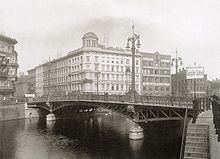Crosses Spree Width 22.5 m (74 ft) Construction started 1895 Total length 73 m Body of water Spree | Longest span 38.5 m (126 ft) Opened 1896 Designer Otto Stahn | |
 | ||
Carries Motor vehicles, trams, pedestrians and bicycles Similar Spree, Moltke Bridge, Crown Prince Bridge, Jungfern Bridge, Jannowitz Bridge | ||
The Weidendammer Bridge is a 73 m (240 ft) long bridge where the Friedrichstraße crosses the Spree river in the central Mitte district of Berlin, Germany. It is notable for its ornate wrought iron railings, lanterns, and Imperial eagles.
Contents
Map of Weidendammer Br%C3%BCcke, 10117 Berlin, Germany
History
In 1685, a wooden drawbridge was built on the site in the course of the creation under Elector Frederick William I of Hohenzollern of a new western suburb of the city, Dorotheenstadt. Named after nearby willow (Weiden) trees on the riverbank, it was demolished for a cast iron construction erected in 1824, one of the first in Central Europe. Too small after the exponential population growth of Berlin as the capital of the German Empire, it was again replaced by the current bridge built between 1895 and 1896.
During the Battle of Berlin, the Weidendammer Bridge was one of the few Spree crossings that had not been destroyed. On the night of 1 May 1945, a Tiger tank from the 11th SS Panzergrenadier Division Nordland spearheaded an attempt to storm the bridge to allow hundreds of German soldiers and civilians to escape across it.
Lovers are known to lock padlocks engraved with their names onto the wrought-iron work on the bridge, and at times, these locks are removed by the authorities.
